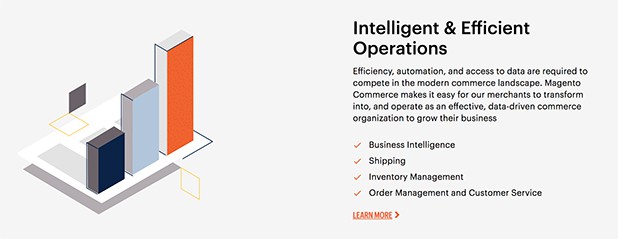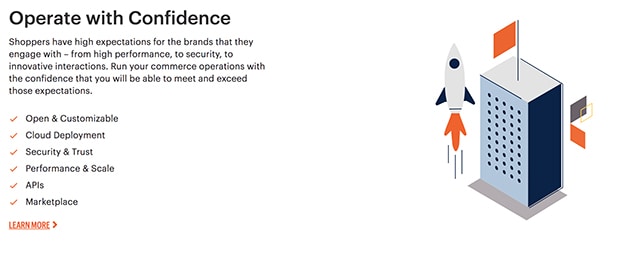As a platform, Magento is powerful. Sites like Graze and Kurt Geiger use Magento to power their online shops but for someone new to e-commerce, with a much smaller customer-base than these huge e-commerce stores, can you afford to run your store on Magento? More importantly, how will your Magento pricing strategy contribute to that?
In this post, we’re going to break down the cost of running a Magento store and give you an idea of how much of your product you’d have to sell in order to run a successful profitable Magento store, to build a solid and profitable Magento pricing strategy.
You’ll learn:
- Which edition of Magento is right for your use-case
- Why the size of your business will affect the type of Magento edition you run
- Why it’s important to factor in your theme costs when building your Magento pricing strategy.
- How to calculate what your potential server costs will be
Magento packages to choose from
Magento Packages have different price points and offerings based on what features you might need. The first step will be to have a clear idea of how big your business is.
Magento Community Edition is a free and open source platform you can use if you run a small store. If you’re running an e-commerce store with under SKUs under 5000, or you simply want to see what benefits you could get from running your store on Magento, this free package is a good one to start with.
With this package, you’re able to set up analytics and reporting systems to keep track of how people interact with your store and provide you with ideas for future optimization.
If you’ve purchased a prebuilt theme, you can integrate or install this directly into your version of Magento. It also has prebuilt shipping and tax configuration.
When it comes to payment, you can accept payment from various payment processors like Paypal, Amazon, Google pay etc.
But you should be aware of the limitations. Unless you purchase external Magento extensions, you’ll be forced to use the default settings.
There’s also no added built-in support features so you might have to hire freelance (or even full-time developer) to help you make changes to your store.
If the free version isn’t right for you, you can use Magento 2 Enterprise Edition. This package works based on revenue. If you have over 5000 SKUs this is a good package for you.
The initial costs for this package are $22,000 per year and can increase anywhere up to $125,000. It’s important to note that licensing for this package starts at $22,000 (even if your store doesn’t generate any revenue.
With Magento Enterprise Edition, you have three master databases, each database can store information, for example, your checkout, your products and all the orders you receive. Separate databases keep your data secure in case of any breaches.
You also have an SEO advantage package which will help your store show up on search engines for any given search criteria.
You’ll also be able to access:
- Inventory & point of sale integrations
- Multilingual support so that you can scale your e-commerce business into multiple international markets]
- One page checkout
- integration with WordPress
- Data migrations
- 301 redirects
- Advanced review system
- Warranty and support
- Social media sharing options.
To have all the features of Magento EE using Magento CE, you’d need to use over 65 extensions to get the same level of functionality. Whereas Magento EE offers a direct straight-out-of-the-box system and saves you having to put everything together from scratch.

Finally, Magento’s most recent package, Magento Enterprise Cloud Edition, is probably the most flexible. For this package, you get to utilize licensing and AWS-based managed to host. This, however, will set you back anywhere from $40,000 to $190,000. This cost, however, is based on projected annual gross sales revenue.
With Magento Enterprise Cloud Edition, you get everything you get with Magento EE, but you also have AWS hosting included. This means your Magento store runs on its own dedicated servers which helps eliminate slow sites and 404 errors. It also mea
Finally, Magento’s most recent package, Magento Enterprise Cloud Edition, is probably the most flexible. For this package, you get to utilise licensing and AWS-based managed to host. This, however, will set you back anywhere from $40,000 to $190,000. This cost, however, is based on projected annual gross sales revenue.
With Magento Enterprise Cloud Edition, you get everything you get with Magento EE, but you also have AWS hosting included. This means your Magento store runs on its own dedicated servers which helps eliminate slow sites and 404 errors. It also means that when your traffic increases, your site can handle the increased influx, without falling apart.
You can also use:
- Page speed improvements including image optimization
- M4 servers with a 100% increase in available memory
- Web Application Firewall (WAF), powered by Fastly with rulesets based on test traffic to cloud sites
- Local development template to ease cloud deployments
- Page speed improvements (20%+) through fast image optimisation
- A super simplified build and deploy process management for your developers
Development costs for Magento
Once you know what Magento package you plan to use, you’ll have a good idea of your main costs. It’s now time to think about your development costs. You’ll most likely need more than one developer.
If you’re running Magento Open Source you should expect to pay anywhere from $3000 to $20000 for a prebuilt theme or to PSD files over to Magento. The costs vary based on the type of developers you work with. Offshore developers are naturally much cheaper but you might prefer a more hands-on approach by working with someone local.
If you’re running Magento Enterprise/Cloud you should expect to pay anywhere from $10000 to $50000 and this includes any integrations with existing data or extensions you might have.
ns that when your traffic increases, your site can handle the increased influx, without falling apart.
You can also use:
- Page speed improvements including image optimisation
- M4 servers with a 100% increase in available memory
- Web Application Firewall (WAF), powered by Fastly with rulesets based on test traffic to cloud sites
- Local development template to ease cloud deployments
- Page speed improvements (20%+) through fast image optimisation
- A super simplified build and deploy process management for your developers
Development costs for Magento
Once you know what Magento package you plan to use, you’ll have a good idea of your main costs. It’s now time to think about your development costs. You’ll most likely need more than one developer.
If you’re running Magento Open Source you should expect to pay anywhere from $3000 to $20000 for a prebuilt theme or to PSD files over to Magento. The costs vary based on the the type of developers you work with. Offshore developers are naturally much cheaper but you might prefer a more hands-on approach by working with someone local.
If you’re running Magento Enterprise/Cloud you should expect to pay anywhere from $10000 to $50000 and this includes any integrations with existing data or extensions you might have.

And if you’re looking for complete integration with themes, shipping providers, multiple stores and built-in modules, you’ll expect to pay a developer $45000 to $75000
Don’t forget to think about your Magento theme and extensions
Just building an e-commerce store isn’t enough. You’ll want your store designed with a theme that matches your overall brand experience. You also might want to make use of a wide range of marketing extensions.
There are currently over 5000 Magento extensions you can use. Some are free but others involve paying a one-time or subscription payment. This price should be factored into your budget to see whether it’s worth running your e-commerce store on Magento. That’s an important step in building a solid Magento pricing strategy.
How to calculate potential server costs when creating a Magento pricing strategy
Your servers are where your Magento store sits. You’ll have to pay for a server and depending on how much traffic you have, will depend on what server costs you need. Ideally, you want to opt for a dedicated server. This means you don’t share your online space with anyone else.
Dedicated server costs can set you $85 and $265. Shared server, prices are lower (between $4 and $14 per month). But do keep in mind, if you use a shared server, you might have to deal with a slower website.
But if you opt for Magento Commerce Cloud, hosting is included with the package. Of course, there are many other options.
Work backward to see if you can affordably run your store on Magento
Working backward, you should see what your one-time and repeatable outgoings are and compare this to how many products you’d have to sell in order to be profitable.
So let’s take three examples.
If you’re running your store on Magento Enterprise Edition, your yearly costs for Magento are $22,000. (That doesn’t take into account costs for marketing, design, customer support and staff salaries.
If you sell your products for an average of $100, you need to sell 220 products each year in order to be in the green for your Magento store.
If you sell your products for an average of $5, you need to sell 4,400 products each year for it to make sense to run your store on Magento.
If you run your e-commerce store on Magento Commerce Cloud, your costs are $75,000.
If you sell your products for an average of $100, you need to sell 750 products each year in order to become profitable.
If you sell your products for an average of $10, you need to sell 7500 products each year in order to become profitable.
So look at your previous sales and see which platform you could affordability run.
Building a profitable Magento pricing strategy
When you first look at the costs of running your store on Magento, it might seem expensive, but it’s a platform that allows you to scale as you grow.
Having a good grasp on your outgoings will help you understand how to price your products to ensure you’re making a healthy overall profit.
pricing strategies


Leave a Reply